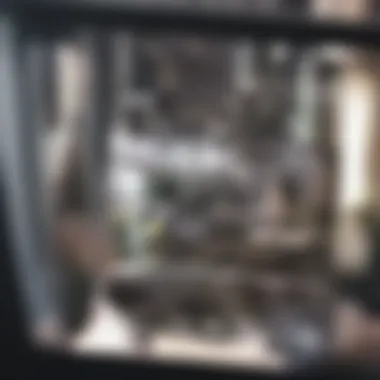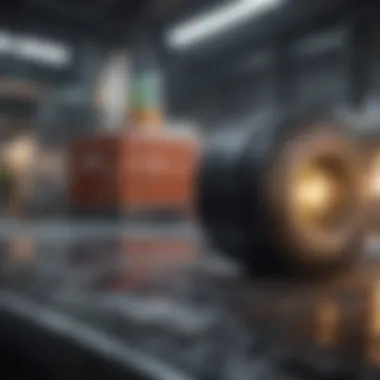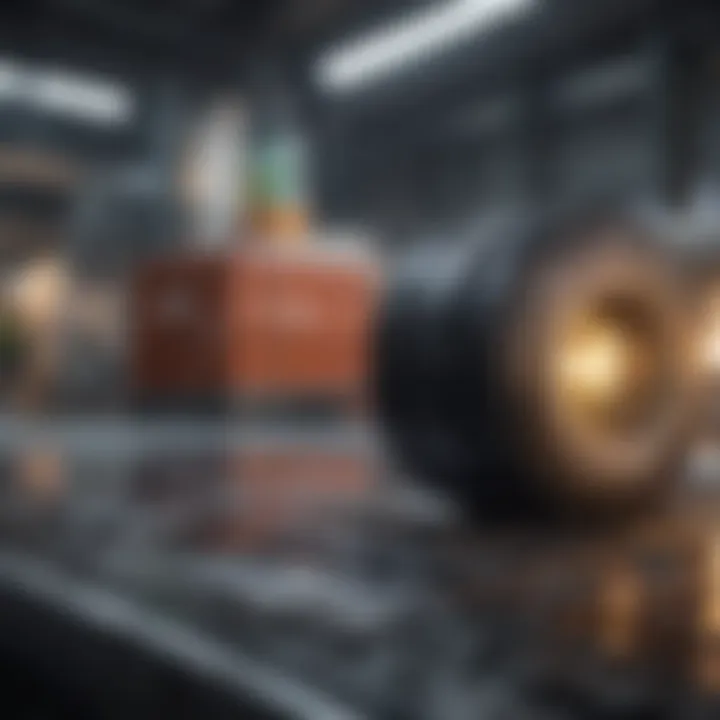Exploring RTM Manufacturing: Principles and Future Trends


Intro
Resin Transfer Molding (RTM) has emerged as a pivotal process in modern manufacturing. Its capacity to produce lightweight, durable materials makes it ideal for various industries. The RTM process involves injecting resin into a mold containing dry reinforcement fibers, allowing for precise control over material properties. This technique has seen increased adoption in sectors like aerospace, automotive, and marine due to its efficiency and versatility.
Understanding RTM manufacturing begins with recognizing its principles and applications. Key benefits include reduced cycle times, enhanced product quality, and minimized waste. As industries strive for sustainability, RTM's inherent qualities align well with evolving demands for eco-friendly approaches in manufacturing.
In this exploration, we will delve into the intricacies of RTM, highlighting notable findings and methodologies. The aim is to provide a thorough understanding that educates students, researchers, and professionals alike.
Key Findings
Major Results
The key findings regarding RTM manufacturing illustrate its transformative impact across multiple industries. Notably, the integration of advanced technologies such as automation and computer-aided design has significantly enhanced the RTM process. The following results have been observed:
- Increased Efficiency: Automation leads to faster production rates, allowing manufacturers to respond to market demands promptly.
- Enhanced Material Properties: RTM enables superior fiber wet-out, resulting in improved mechanical properties and overall product quality.
- Reduced Waste Generation: The closed-mold process minimizes excess material, contributing to a more sustainable manufacturing method.
Discussion of Findings
The data collected shows clear advantages of RTM over traditional manufacturing techniques. Application-specific studies reflect that employing RTM can lead to:
- Low void content in composite materials,
- A decrease in labor intensity,
- The facility of integrating multi-material design, catering to the needs of complex geometries.
Challenges remain, particularly in terms of raw material costs and the need for skilled labor. However, continuous advancements in resin formulations and training programs are addressing these hurdles.
Methodology
Research Design
This exploration utilized a qualitative research design underpinned by case studies and industry interviews. The data encompassing RTM processes, technological advancements, and industry challenges were gathered from reputable sources alongside firsthand accounts from professionals in the field.
Data Collection Methods
Data was collected through the following methods:
- Literature Review: Analysis of academic papers and industry reports to assess current trends and historical context.
- Interviews: Engaging with industry experts for insights into the real-world applications and challenges faced in RTM manufacturing.
- Surveys: Distributing questionnaires to collect quantitative data regarding the operational aspects and perceptions surrounding RTM.
Overall, these methodologies ensure a comprehensive understanding of RTM manufacturing, allowing for an accurate assessment of its potential and future developments.
Foreword to RTM Manufacturing
The exploration of Resin Transfer Molding (RTM) manufacturing reveals essential insights into a process that has gained significant traction across various sectors. This introduction sets the stage for understanding RTM's unique characteristics, operational efficiencies, and benefits that set it apart from traditional manufacturing techniques. In today’s competitive landscape, the ability to adapt and implement advanced manufacturing processes is crucial.
Definition of RTM
Resin Transfer Molding is a composite manufacturing process where a resin is injected into a dry fiber preform within a closed mold. This method allows for the production of complex shapes while ensuring uniform material distribution and enhanced structural integrity. The key advantage lies in its ability to utilize various materials, including fiberglass and carbon fiber, thus enhancing the final product's performance and durability. The RTM process is especially noted for its ability to reduce waste, allowing for better material usage compared to other methods like hand layup. RTM stands out because of its adaptability in producing both large and small components for a range of industries.
Historical Context
The roots of RTM can be traced back to the aerospace industry in the 1980s, where the need for lightweight yet durable materials became paramount. At that time, engineers were seeking alternatives to traditional materials to improve fuel efficiency and reduce overall weights of aircraft. The introduction of resin transfer molding provided a solution, allowing manufacturers to create complex shapes that were previously difficult or impossible to achieve. Over the decades, RTM has evolved, branching into various sectors, including automotive and marine engineering. Its historical development is marked by continuous innovations, making it a preferred choice for engineers that prioritize sustainability and efficiency in manufacturing processes.
RTM process emphasizes reduced production times and enhanced product quality, making it essential for modern manufacturing needs.
Fundamentals of RTM Process
The Fundamentals of RTM Process play a crucial role in understanding the overall efficiency and effectiveness of Resin Transfer Molding manufacturing. Recognizing these fundamentals offers insights into how components are designed, built, and refined throughout the manufacturing cycle. It highlights the core principles, materials, and equipment that are essential for RTM, which makes it vital for professionals in the field.
Core Principles
Core principles of RTM involve fundamental techniques that define how the process operates. At its heart, RTM is about injecting resin into a mold, which contains reinforcing fibers. The basic idea is simple, yet the execution must be precise. First, the mold design should ensure optimal flow of the resin. Secondly, the selection of fibers, like glass or carbon, impacts the strength and weight of the finished product. Thirdly, applying the correct pressure during the injection plays a significant role in ensuring a complete fill and eliminating air pockets. These principles are pivotal as they set the stage for consistency and quality in production.
Materials Used
Different materials are employed in RTM, each chosen for its properties that fit specific product needs. The most common are:
- Resin: The base material, typically epoxy, polyester, or vinyl ester. Each type provides unique characteristics, such as strength or resistance to temperature.
- Reinforcement Fibers: Glass fibers are often used for their cost-efficiency, while carbon fibers are chosen for high-performance applications.
- Additives: Various additives can be introduced, such as accelerators or pigments, to enhance certain properties. Understanding the interaction between these materials is crucial to creating high-quality manufactured parts.
RTM Equipment


Equipment used in RTM manufacturing includes several key components designed to facilitate the process:
- Injection Machines: These machines are responsible for the precise injection of resin into the mold. They must maintain consistent pressure and temperature.
- Molds: Mold design is paramount. They are often made from aluminum or steel to withstand pressure and ensure durability during the production cycles.
- Curing Stations: After injection, the resin needs a curing phase. This may involve heat and pressure to solidify the resin completely, leading to the desired mechanical properties in the final product.
The effectiveness of RTM manufacturing relies heavily on these fundamentals. By mastering core principles, wisely choosing materials, and using appropriate equipment, manufacturers can optimize the RTM process for various applications.
RTM Process Workflow
The RTM Process Workflow is essential in understanding how Resin Transfer Molding operates. It encompasses a series of steps that are critical to producing high-quality composite materials. Each step is interconnected, contributing to the efficiency and effectiveness of the final product. A thorough comprehension of this workflow allows stakeholders to optimize production processes, minimize waste, and enhance product performance.
Preparation Stage
The Preparation Stage lays the groundwork for the entire RTM process. It involves meticulous planning and setup, ensuring that all materials and equipment are in place. During this stage, the mold is cleaned and prepared. Proper mold release agents are applied to facilitate easier demolding later.
Moreover, technicians must verify that the correct fabric or composite material is selected. This choice is often driven by the specific application requirements. Preparation also includes checking the injection system for any potential issues. Ensuring that the resin and hardener are correctly mixed and heated sets the stage for the subsequent injection process. Inadequate preparation can lead to defects in the final product.
Injection of Resin
The Injection of Resin is a pivotal moment in the RTM process. Once the mold is prepared and the resin mixture is ready, the resin is injected into the cavity. Various methods can be used for this injection, including gravity feed or high-pressure systems depending on the complexity and size of the mold.
This stage requires precision to ensure even flow and complete wetting of the reinforcement materials. Air entrapment must be avoided as it may compromise the integrity of the laminate. The control over resin viscosity and injection pressure is crucial. Both aspects influence how well the resin will saturate the fabrics and ultimately affect the mechanical properties of the molded part.
Curing Process
Following injection, the Curing Process transforms the injected resin into a solid state. This stage is typically governed by temperature and time. The right curing conditions are critical for achieving the desired material properties.
Curing can be accelerated through heat, depending on the type of resin used. Thermoset resins require specific temperatures to ensure optimal bonding between the fibers and resin. Monitoring curing time is equally important, as insufficient curing can lead to weak spots in the final product. It is during this stage that the composite begins to take on its shape and strength.
Demolding Procedures
The final step in the RTM Process Workflow is the Demolding Procedures. Once curing is complete, the component can be removed from the mold. This task must be performed with care to prevent any damage to the newly formed part. Using appropriate tools and techniques minimizes the risk of chipping or cracking.
After demolding, components often undergo additional quality control checks. Inspecting the parts for defects, such as bubbles or incomplete filling, is essential to ensuring that they meet required specifications. Finally, the finished product may need surface finishing or machining, depending on its intended application.
Proper execution of the RTM process workflow is crucial for meeting performance standards in composite manufacturing.
Advantages of RTM Manufacturing
Resin Transfer Molding, or RTM, offers various advantages that make it a preferred choice in multiple industries. This section delves into the pivotal aspects of RTM manufacturing, emphasizing the efficiency, material utilization, and enhanced performance characteristics inherent in its process.
Efficiency and Reproducibility
One of the most significant advantages of RTM manufacturing is its efficiency. The process allows for high-volume production with minimal waste. RTM uses a closed mold method, which means that the resin is injected into a preformed mold that holds the fiber reinforcement. This setup helps in controlling material usage more effectively compared to open molding techniques.
The reproducibility of parts is also notable. Each cycle in RTM manufacturing is consistent, leading to uniformity in the final product. When molds are maintained properly, they can produce identical parts repeatedly, which is crucial for industries needing precision, such as automotive and aerospace.
Material Utilization
RTM offers better material utilization compared to traditional methods. The ability to inject resin into a closed mold means that most of the resin can be used, with little to no waste produced. Materials like carbon fiber, fiberglass, or other reinforcements are often used effectively in conjunction with the resin. This efficient use of materials directly contributes to cost savings and reduces the environmental impact of manufacturing.
This method significantly decreases the quantity of raw materials needed throughout the manufacturing process. Moreover, RTM allows for the integration of lightweight materials, which is increasingly demanded in industries focused on efficiency and performance.
Enhanced Performance Characteristics
The performance characteristics of products made via RTM are generally superior. The controlled environment of the closed mold leads to better fiber wet-out and uniform thickness throughout the part. This results in strong, lightweight components that meet demanding specifications.
Components manufactured through RTM exhibit excellent mechanical properties, such as high tensile strength and resistance to temperature and corrosion. These advantages are desirable in high-stress applications, especially in the aerospace and automotive sectors.
"RTM not only enhances product qualities but also provides insights into the evolving standards within manufacturing practices across various industries."
Applications of RTM Manufacturing
The applications of Resin Transfer Molding (RTM) manufacturing are diverse and significant across various industries. These applications provide insights into how RTM technology is utilized to achieve specific outcomes, reinforcing its importance in modern manufacturing processes. This section discusses key industries employing RTM, emphasizing the advantages and considerations inherent to each field.
Aerospace Industry
The aerospace industry is one of the primary sectors that benefit from RTM manufacturing. Composite materials are critical in this domain due to their high strength-to-weight ratio, which is essential for enhancing the performance and efficiency of aircraft. RTM allows for the production of intricate and lightweight components such as wings and fuselage sections.


Key Benefits:
- Reduced weight, leading to fuel efficiency.
- Improved structural integrity.
- Capability to produce complex geometries with minimal waste.
However, aerospace applications demand strict compliance with regulations and quality standards. Testing methods must ensure that components meet safety and performance criteria, necessitating rigorous quality assurance practices.
Automotive Sector
In the automotive sector, RTM is used predominantly for manufacturing body panels, structural components, and interior parts. Manufacturers in this industry are drawn to RTM's effectiveness in producing high-quality parts with consistency and precision.
The use of composite materials in automotive applications contributes significantly to vehicle performance and efficiency.
Specific Advantages for Automotive:
- Cost-effectiveness in mass production.
- Enhanced durability against corrosion.
- Flexibility in design, permitting customization options for various vehicle models.
Adopting RTM technology also involves addressing both environmental concerns and market demands for lighter, more efficient vehicles.
Construction and Marine
RTM is increasingly utilized in the construction and marine sectors to create durable, lightweight structures that can withstand challenging conditions. In construction, RTM facilitates the manufacture of panels, beams, and other structural components that maintain structural integrity while minimizing weight.
In the marine environment, RTM is used to produce boat hulls and other key components that require a strong resistance to corrosion and impact. This application underscores the material's versatility.
Essentials for Construction and Marine:
- Long-lasting performance in harsh environments.
- Ability to create specialized treatments for surfaces to enhance longevity.
- Contributions to faster construction timelines with automated processes.
Overall, the applications of RTM manufacturing span several industries, each harnessing its unique benefits to address specific challenges. Through efficient production, material utilization, and enhanced performance, RTM continues to shape the future across these vital sectors.
Challenges in RTM Manufacturing
Understanding the challenges in RTM manufacturing is crucial for achieving operational excellence. Despite its advantages, this manufacturing method is not without difficulties. Industry professionals must navigate various obstacles to optimize the RTM process. Each of these challenges offers insights into the state of the industry and identifies areas for improvement.
Cost Factors
Cost management is one of the most pressing concerns in RTM manufacturing. The initial investment for RTM setup can be substantial. Equipment costs, along with the price of raw materials such as resins and reinforcements, can strain budgets. Additionally, the costs associated with maintaining high-quality standards throughout production must be considered.
In many cases, companies can expect slower ramp-up times, which further affects production expenses. Hence, there is a need for effective budgeting and financial forecasting. Optimizing processes to reduce waste and enhance efficiency can help mitigate costs to some extent. By carefully analyzing the cost structures involved, manufacturers can strategize better.
Technological Limitations
Technological constraints present significant challenges in RTM manufacturing. Many current systems lack the necessary flexibility to adapt to varying production demands. Equipment may not be advanced enough to handle different types of resins or complex geometries that some projects require. This limitation can hinder innovation.
Moreover, older technologies may struggle with quality control. High-performance standards become harder to meet without access to the latest machinery or processes. Integrating new technologies such as automation or data analytics could improve output and consistency in RTM applications. Manufacturers must stay updated with technological advances to maintain competitive advantages.
Skill Gaps in Workforce
The competency of the labor force plays a vital role in the success of RTM manufacturing. A notable challenge is the skill gap among workers. Many new entrants into the industry lack essential training in the nuances of RTM. This deficiency can lead to production errors and inefficiencies.
To address this, ongoing education and training programs must be prioritized. Collaboration with educational institutions can create pathways for training skilled technicians and engineers. Additionally, companies need to foster a culture of learning. Investing in employee development can yield significant returns in performance and production quality.
"Addressing challenges in RTM manufacturing is vital for improving efficiency and market responsiveness."
In summary, the challenges in RTM manufacturing—cost factors, technological limitations, and skill gaps—are interconnected. Awareness of these issues can lead to strategic decisions that enhance the overall efficacy of the manufacturing processes.
Future Trends in RTM Manufacturing
The examination of future trends in RTM manufacturing is crucial for understanding how the industry will evolve. With advancements in technology and market demands, RTM processes are adapting to meet the growing need for efficiency and sustainability. Companies are seeking ways to innovate and enhance their manufacturing capabilities, thus, it is vital to study these trends. The focus areas include innovative technologies, sustainability practices, and global market dynamics.
Innovative Technologies
Technological innovation is at the forefront of the RTM manufacturing process. New tools and methodologies are dramatically changing how manufacturing occurs. Notably, automation technology is transforming traditional practices. The adoption of robotic systems enables more precise resin injection and reduces the likelihood of human error. This reliability serves to enhance productivity while maintaining quality standards.
Moreover, the integration of Artificial Intelligence (AI) and machine learning in monitoring production processes is increasing. These technologies analyze real-time data, allowing for predictive repairs and optimized workflow. This not only saves time but also reduces operational costs. Another important development is the rise of advanced composite materials. These materials complement RTM manufacturing by offering enhanced performance characteristics and weight reduction. In turn, this enhances the usability of RTM products across various sectors, including aerospace and automotive.
Sustainability Practices


Sustainability is an essential aspect of future trends in RTM manufacturing. As industries face growing scrutiny over environmental impact, the RTM sector is also making strides to become more eco-friendly. Manufacturers are now focusing on using recycled materials in their processes. This practice is not only beneficial for the environment but also helps companies reduce costs associated with raw material sourcing.
In addition, companies are exploring bio-based resins as an alternative to traditional synthetic options. These resins decrease carbon footprint and promote sustainable practices within manufacturing. Another area of focus is energy efficiency. Manufacturers are implementing systems designed to reduce energy consumption during the curing and processing stages, thus aligning with global sustainability goals. In summary, the RTM industry is actively seeking methods to minimize waste and energy usage, recognizing the importance of sustainable practices.
Global Market Dynamics
Understanding global market dynamics is imperative for RTM manufacturing. The industry is influenced by economic factors and technological advancements that shape production opportunities. Emerging markets present significant potential for growth. Countries in Asia and South America are investing in the aerospace and automotive sectors, which increases the demand for advanced manufacturing technologies like RTM.
Moreover, the competitive landscape is changing. Established manufacturers are collaborating with startups to leverage innovative solutions, boosting productivity and expanding their market reach. Regulatory changes also play a crucial role. Compliance with new environmental standards can influence which materials and processes are adopted. Firms that adapt to these dynamics can position themselves advantageously in the market.
"The future of RTM manufacturing hinges on adaptability and innovation, understanding market trends can spell the difference between success and stagnation."
Integration with Digital Manufacturing
The integration of digital manufacturing into RTM (Resin Transfer Molding) represents a paradigm shift in how products are conceptualized, produced, and refined. This connection allows manufacturers to leverage data-driven insights and automated processes, enhancing efficiency and innovation. Digital manufacturing acts as a bridge that connects design, production, and management systems, streamlining workflows and improving quality control. It is essential to examine specific elements such as automation and data management to understand the full impact of this integration.
Role of Automation
Automation plays a crucial role in modernizing RTM manufacturing. Through automated systems, manufacturers can optimize production schedules, manage material handling, and ensure precise control over the injection process. Automated machinery can reduce human error, which in turn can lead to higher-quality outputs.
- Predictive Maintenance: Automation allows for predictive analysis on machinery, which reduces downtime.
- Process Monitoring: Real-time data collection enables instant adjustments to maintain optimal conditions during production.
- Supply Chain Efficiency: Automated supply chain management helps in consistent material availability, ensuring smooth production flows.
With these advantages, automation not only increases efficiency but also enhances the overall reliability of the RTM process.
Data Management in RTM
The role of data management cannot be understated in the context of RTM. In a manufacturing environment, effective data management facilitates better decision-making and supports continuous improvement.
- Data Collection: Gathering data from various stages of the production process can provide insights into performance and quality metrics.
- Analysis: Employing data analytics to interpret this information allows companies to identify trends and anomalies in product quality.
- Integration Systems: Using integrated software systems helps in managing this data seamlessly across departments, from design to final quality checks.
Robust data management practices can lead to substantial cost savings, enhance product quality, and maintain competitive edge in the market.
Quality Assurance in RTM
Quality assurance in Resin Transfer Molding (RTM) is a critical aspect of the manufacturing process. It ensures that parts produced meet specific standards and customer requirements. Proper quality assurance is fundamental to minimizing defects and maintaining consistency in production. High-quality products not only satisfy customers but also promote trust and reliability in the manufacturing company.
Standards and Regulations
Various standards and regulations guide quality assurance in RTM. For manufacturers, compliance with these standards is not optional. Organizations such as ISO (International Organization for Standardization) provide frameworks that outline best practices for manufacturing processes.
In the context of RTM, the relevant standards may include:
- ISO 9001 - Focuses on quality management systems, ensuring consistent quality in products and services.
- ASTM (American Society for Testing and Materials) - Offers specifications for materials and testing methods used in the RTM process.
- SAE (Society of Automotive Engineers) - Establishes criteria for automotive applications, which is essential in ensuring safety and performance.
Adhering to these standards is beneficial as it fosters continuous improvement and reduces risk of failure in production.
Testing Methods
Testing methods play an essential role in quality assurance for RTM. They help verify that products meet required specifications before they reach the market. Common testing methods used include:
- Visual Inspection - Simple yet effective, this method involves examining products for visible defects like surface flaws or incomplete curing.
- Mechanical Testing - This includes tensile tests, flexural tests, and impact tests to assess the mechanical properties of the molded part.
- Non-Destructive Testing (NDT) - Techniques like ultrasonic testing can detect internal flaws without damaging the part.
- Thermal Analysis - Methods like Differential Scanning Calorimetry (DSC) can evaluate the curing behavior and thermal properties of the resin used.
In summary, effective quality assurance in RTM ensures superior products, which aligns with industry standards and customer expectations. This not only enhances safety but also promotes long-term success for manufacturing companies.
Culmination on RTM Manufacturing
The process of Resin Transfer Molding (RTM) stands as a pivotal method in the field of manufacturing. Its significance lies not only in the production of high-quality composite parts but also in its ability to adapt and integrate with modern technological advancements. This conclusion highlights the core elements that encapsulate RTM manufacturing, along with the benefits and considerations relevant for stakeholders in various industries.
A primary element is the efficiency that RTM offers. The method enables faster production cycles compared to traditional techniques, thus catering to market demands effectively. With the rise of industries focused on lightweight and high-strength components, RTM finds itself at the forefront of material innovation. Notably, the ability to use diverse materials expands its applicability across sectors ranging from aerospace to automotive.
Moreover, RTM emphasizes sustainability. In an era where resource management is crucial, the method allows for optimal material utilization, minimizing waste. This characteristic makes it an attractive choice for companies aiming to lower their environmental footprint. Integrating eco-friendly practices within RTM processes contributes positively to industry standards, boosting public perception for companies that adopt these methods.
Consideration must also be given to the challenges faced in RTM manufacturing. Factors such as initial setup costs and the technology’s continued evolution require ongoing investment and workforce training. Addressing skill gaps remains vital to fully harnessing RTM's potential. Companies must be vigilant in adapting to technological shifts and ensuring that their workforce is well-prepared for emerging practices in RTM.
"While the challenges are significant, the benefits of RTM manufacturing are noteworthy for those willing to invest in the future."
Summary of Key Points
In summary, the conclusion on RTM manufacturing encompasses several critical points:
- Efficiency: The ability to produce components faster is crucial in meeting modern production demands.
- Material versatility: RTM supports the use of a wide range of materials, which is essential for various applications.
- Sustainability: Lower waste generation promotes eco-friendly manufacturing practices.
- Investment and Training: Ongoing investment in technology and workforce is necessary to overcome challenges and remain competitive.
Final Thoughts
Reflecting on the landscape of RTM manufacturing, it is evident that this method is not only vital for current industrial needs but also positions itself as a transformative approach for future developments. As companies navigate the complexities of global manufacturing, embracing RTM could yield significant advantages.



